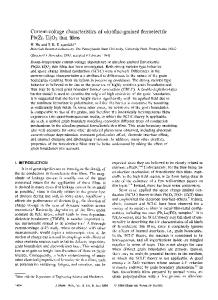Characteristics and Applications of Sr-Modified Ferroelectric Pb(Zr,Ti)O 3 Thin Films
- PDF / 1,247,740 Bytes
- 6 Pages / 417.6 x 639 pts Page_size
- 95 Downloads / 365 Views
roelectric properties are continuously changed with varying Zr/Ti composition ratio. In addition, the modified PZT films that are applicable to specific devices are easily obtained by means of the substitution of other elements such as La 2 , Nb3 and Bi 4 for Pb. However, in Pbbased ferroelectric thin films including PZT and PTO, Pb (or PbO) may be easily diffused in electrodes of novel metal, such as Pt, Ru and Ir, and forms undesirable interfaces such as Pt 5 _7Pb5 , Pb-Ru6 and Pb-Ir-07, which may cause the structural defects and the degradations including polarization fatigue, retention, imprint and high leakage current. Moreover, using PZT or PTO, the fabrication of 1-transistor FRAM with a structure of MFIS (metal-ferroelectrics-insulatorsemiconductor) or MFS (metal-ferroelectrics-semiconductor) may be difficult without specific processing such as bonding techniques 8 . In this study, we prepared Sr-modified PZr thin films with a form of (Pbl,Sr×)(Zro 53Tio.47)03 (PSZT) by means of the sol-gel method. The structural and electrical properties, as well as the applications, of PSZT films were investigated with a function of Sr composition in PSZT. The characteristics of Sr-modified PTO films were also investigated. EXPERIMENTAL PROCEDURE The one-step sol-gel method used in this experiment is shown as a flow chart in Fig. 1. The staring materials were lead acetate, zirconium n-propoxide, titanium isopropoxide and 235
Mat. Res. Soc. Symp. Proc. Vol. 596 ©2000 Materials Research Society
Zr-n-propoxidej I
K
i-isoro
oide•o
,--
glacial acetic acid
C:
--
X=:.5
n-pro anol
X-z 4
Pb-acetate & Sr-acetate heating t 140 0C glacial acetic acid
X.:0.3
."
D .Iwater & n- ropanol
C-Z S
PSZT precursor •sin coating (4000rpm) wet PSZT filmrnj
"
,0.0
3 times
d•ring at 3000 amorphous PSZT film Tarnealing at 500-650 0 C perovskite PSZT film_] Fig. 1. Flow Chart of the preparations of PSZT films by the one-step sol-gel route.
20
25
30
35
40
45
50
two theta (deg.) Fig. 2. XRD patterns of PSZT films deposited on Pt/Ti/Si0 2/Si wafers.
strontium acetate. Acetic acid, n-propanol and D. I. water were selected as solvents for the 0.4 M PSZT precursors. Since the molar ratio of acetic acid to titanium isopropoxide for dissolving strontium acetate was different at around x=0.5, PSZT precursors were synthesized only for x=0.0 to 0.6. Wet PSZT layer was spin-coated on platinized silicon wafers at 4000 rpm for 40 s and then placed on a hot plate at 300 TC for 3 min to burn out the organics. After this procedure was repeated three times, specimen was finally annealed at 650 TC for 30 min in 02 ambient. The resultant thickness of PSZT layer was 260 nm ± 10 nm, which was also determined using a spectroscopic ellipsometer. The crystallinity of the PSZT samples was investigated by X-ray diffraction. Pt top electrodes of 140 nm in thickness and 3.5x10-4 cm-2 in area were sputterdeposited using a shadow mask and were annealed at 600 TC for 2 min prior to the electrical measurements. P-E hysteresis loops and polarization fatig
Data Loading...











